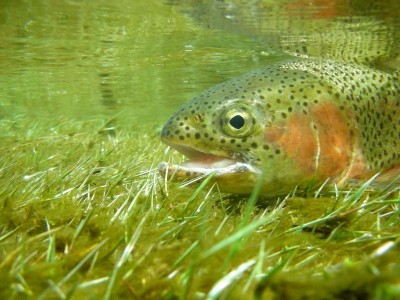USDA researchers seeking to leverage feeds to boost trout performance

The team, also comprised of scientists from the Fish Technology Center in Montana and the Trout-Grains Project in Idaho, is involved in a five-year project that began in 2014 and looks at making trout production more sustainable through a variety of different avenues.
One such avenue is the development of feeds that replace the protein and lipid components of costly and finite marine raw materials resources.
Other intended outcomes of the USDA initiative include finding ingredients that reduce costs and improve diet formulation, dampening the release of nutrients into the environment and identifying beneficial fish traits and improving strains.
“We’re comparing different strains of rainbow trout trying to find specific strain diets and life stage management diets,” Rick Barrows, research physiologist, USDA Agricultural Research Service (ARS), told FeedNavigator.
The researchers are also seeking to generate lines of rainbow trout with enhanced abilities to biosynthesize eicosapentaenoic acid (EPA) and docosahexaenoic acid (DHA) from plant oils and deposit these nutrients in muscle tissue.
Moreover, the USDA led project will explore the isolation and identification of trout microbiota and examination of its role in enhanced tolerance to plant-based feeds.
Anti-nutrient control
An initial step in the process will be working on ways to mitigate the diarrhea causing aspects of some replacement ingredients like soymeal, said Barrows. The team wants to develop an improved soybean processing method to allow for high protein and oil recovery while simultaneously removing the anti-nutrients.
The specialists said various non-traditional feed ingredients, including protein and energy sources, will be identified and evaluated in trout.
The group has already established a database of more than 120 ingredients that can be used in fish feed and is continuing their development, said Barrows.
The research team is also aiming to develop a high protein ingredient from whole wheat or bran with less gluten protein and reduced binding capacity, to allow for more to be used in aqua feeds and will also examine the benefits of using grains like barley and oats.
How cost efficient some of the alternative feeds are may depend on future fluctuation of the ingredient markets, noted the team. “Ingredient markets are volatile, and the more knowledge we have, the more alternative feeds will fit into the equation,” said Barrows.
Fishmeal replacement
Previously, Barrows and his USDA colleague, Jason Frost, explored various potential fishmeal replacers for fish diets.
Their research, published in the journal Aquaculture in October 2014, examined the effects of nut meals, algae meal and mussel meal on the performance of rainbow trout.
The authors said their experiments showed that “pistachio and almond meals are palatable, digestible, and support high levels of growth whether replacing fishmeal or soy protein concentrate (SPC).”
The initial part of their study found that fish receiving a test diet of 5% fishmeal and pistachio or almond meal gained the same amount of weight as fish getting a diet with 45% fishmeal, researchers said. The mussel and algae meals used were not as successful and those two ingredients were dropped from the study.
The apparent digestibility coefficients for the two nut meals and were found to be similar to fishmeal, though the pistachio meal was lacking in phosphorus, said the authors.
In the last part of the experiment, trout were fed one of 10 diets for 12 weeks, the researchers said. The diets included either 50% or 100% fishmeal, replaced with pistachio or almond meal, or a diet using SPC that was either 50% or 100% replaced with the nut meals.
Trout getting fishmeal or a nut meal had similar weight gains, though they were lowest for fish getting 50% almond meal, the USDA scientists said. Fish getting the soy meal or nut meal replacements also saw similar weight gain, except for fish getting a 100% pistachio meal – they reportedly had the highest weight gain.
Source: Aquaculture
Title: Evaluation of the nutritional quality of co-products from the nut industry, algae and an invertebrate meal for rainbow trout, Oncorhynchus mykiss
DIO: 10.1016/j.aquaculture.2014.08.037
Authors: F. Barrows, J. Frost














